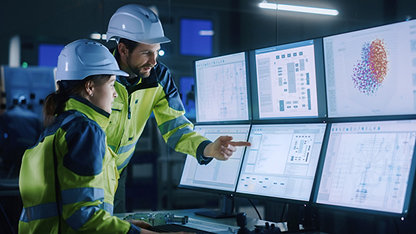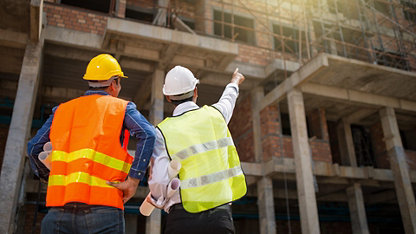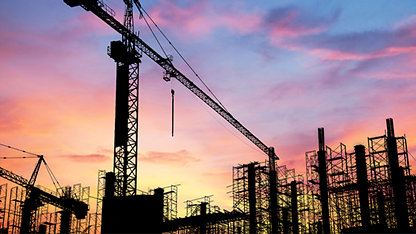1. Energy efficiency: Centre for Energy Epidemiology takes stock
Previously, assumptions about energy use were based on imprecise averages and estimates, but our growing ability to gather huge amounts of data, as well as developments in fields such as artificial intelligence (AI) and smart meters offers an opportunity to analyse energy demands on a more granular level, and make more effective policy as a result.
For the past six years, University College London's Centre for Energy Epidemiology (CEE) has been at the forefront of this data-driven approach, which has enabled it to find, for example, that dwellings are leakier than their regulated design targets, and that electricity use is 2.5 times greater in offices of more than 20 storeys than in low-rise buildings. As well as developing tools to gather and analyse data, it has created 3DStock, which uses digital maps and commercial rating data to generate 3D energy models of entire cities.
In June, the centre started working with the Greater London Authority to develop the London Building Stock Model, which will contain data including dimensions, purpose and construction on every building within the M25 orbital motorway in an effort to tackle fuel poverty and improve energy efficiency. A four-year collaboration with universities in India will involve creating a 3D Building Stock Model in India, using an existing city and a planned one as examples.
2. Building scanning: Matterport breaks 3D modelling mould
Matterport isn't the first company to sell cameras that enable its customers to create a 3D model of their properties. Where its strategy differs is to integrate that hardware with software, via a subscription to its online platform.
Customers download the Matterport app and scan the property using their camera. They upload the data into their account where the model can be edited, customised and refined. The model can then be shared privately via a link or distributed by uploading to Google Street View and on social media.
Landlords and occupiers can drive more traffic to their businesses' websites by providing potential customers with a clearer understanding of what their experience will be if and when they travel to the places captured.
Matterport has uploaded 1.5 million spaces in 100 countries but aims to expand to 100 million spaces and create an open-source "digital twin" for all spaces on earth. To aid this expansion, new chief executive, RJ Pittmann, former chief product officer at eBay, presided over a $48m fundraising in March, which valued the company at $325m.

3. Data visualisation: 3D scanning goes mainstream
Veteran geomatic land surveyor Nick Blenkarn MRICS, director at Severn Partnership and MD of Seeable, explains recent advances in laser-scanning technology and democratising access to 3D data.
What impact have recent advances in 3D laser scanning had on the profession?
There is a huge variety of scanning options available. For the surveyor, it's just a matter of picking the right tool for the project. Advances in software have made things really exciting. It's now possible to view a whole city's worth of mobile mapping data in real time. A client with limited technical skills can simply click on a link to view 360º panoramas of buildings, take measurements, and start building up a database of useful information.
What prevents projects from accessing the benefits?
Procurement is stuck 20 years in the past and there's a big issue with the level of knowledge in construction teams. The client might procure a drone image of the site for archaeology or a ground investigation, then at a later stage ask a surveyor to scan everything using tripod-based laser scanners.
But a much faster and cheaper solution would be to initially use a high-accuracy drone to map and mesh 70% of the project, then do a single day of tripod fieldwork to infill the remaining detail. That mesh and related engineering data can then be used to create visualisations for stakeholder engagement, master planning, health and safety briefings and marketing.
Seeable develops bespoke 3D visualisation apps for various end users. Why did you set it up?
Projects invest huge sums of money in 3D or BIM for use in design, but then the data is simply shelved and the value lost. We are able to recycle that data into apps for use in safety briefings, marketing or tender information to enable others to understand your site or asset. We aim to democratise access to data and exploit the fact that many consumer-grade mobiles and tablets now have built-in firmware and software to deliver augmented reality [AR] and virtual reality [VR] interactive 3D. For example, yesterday we carried out a scan survey of a major asset for Historic England. By this morning, the model was processed in the cloud and the client could view it on their mobile over a 4G connection.
Where is geomatic surveying technology headed over the next five years?
Visualisation and 3D data are increasingly merging together. US company Matterport [see number 2] recently released a "cortex engine" that uses artificial intelligence (AI) to convert 360º panoramic images into relatively accurate 3D. If a 360º image can generate 3D content through AI and machine learning, then we could soon have algorithms able to convert 360º video to point-clouds and scan without direct measurement.
The spread of AR and VR as commercial, off-the-shelf tools will also hopefully embed "immersive visualisation" as a category on the procurement portals of construction companies.
4. Mapping: Colouring London's online collaboration
Launching this year, Colouring London – a project by the Bartlett Centre for Advanced Spatial Analysis at University College London – aims to collate an open, visually accessible database of information on every building in London through a massive exercise in online crowdsourcing from citizens, public and research bodies and businesses.
It comprises a website – developed in conjunction with Ordnance Survey, the Greater London Authority and Historic England – which asks people to plug in historical and current information about a building, centred around 12 categories, ranging from its age and material to whether people like it.
The data will be visible to all in the form of an eye-catching interactive website that recalls the detailed, colourful maps that were made in the 19th century by social researcher and reformer Charles Booth.
The idea is to make information about London's built environment more transparent for both policy-makers and the general public, thereby helping with all manner of urban challenges, such as the heavy contribution that the built environment makes to global energy consumption, with which data about the age and construction of buildings can help.
Information about specific construction systems and materials could allow developers to better target retrofitting and plan repairs. Demolition data and a "like me" facility could empower community groups to identify their favoured local assets to help ensure they are protected or considered in any future development plans.
5. Valuation: cloud-based RockportVAL speeds up valuations
Helping valuation professionals analyse deals more efficiently and make informed decisions faster, RockportVAL's cashflow modelling and valuation platform is based entirely online and in the cloud, eliminating the need for costly IT infrastructure requirements or support.
"Being cloud based, it is a more user-friendly, affordable and powerful alternative to the antiquated 'norm' in real estate modelling software," says Stu Sleppin, managing director of RockportVAL. Furthermore, it can model real-time scenarios on multiple market leasing assumptions without creating separate models, and easily integrate with other industry technologies. "It was built with collaboration in mind," adds Sleppin.

6. Flood defence: Arup futureproofs Leeds flood risk
In 2017, engineering consultant Arup completed the first part of a large-scale project to reduce flood risk in Leeds, West Yorkshire, with an urgency exacerbated by a storm that hit the city two years before, causing £37m of damage. The immediate interventions to tackle this problem were targeted at the River Aire, and involved the removal of an island that was creating a bottleneck, the introduction of mechanical weirs and 3m-high walls along the riverbank – measures designed to combat the effects of the water overflowing, and to provide protection against a once-in-100-year storm until the year 2069.
But the city was also at risk of surface water flooding, in part owing to intense local rainfall – levels average 1,025mm per year and it rains 152 days out of 365. Tackling this risk involved understanding and changing the way water flowed through the city. Arup developed a 275 km² (106 square mile) integrated urban drainage model for Leeds City Council – one of the largest such systems in Europe to date. This holistic approach to city water systems has been made possible by recent advances in computer technology, which allow better data gathering and analysis, and enables easier prediction of city-wide flooding.
In this instance, Arup brought together past and present records of the Yorkshire Water network of sewers, five watercourses, laser survey data from across the city, and a detailed ground model and building outlines. The model that emerged painted an accurate portrait of the city and how it reacts to surface water and heavy rainfall in the areas that were most likely to flood. This was combined with information about the dynamic conditions of the river flow to create detailed assessment of overland water paths through the city centre.
The engineer modelled three different scenarios: a situation in which the river levels were very high but there was a low level of rainfall, one where river levels were lower but rainfall was severe, and a middle option. As well as the water levels being lowered by the mechanical weirs, which would respond to predictions about the city as a whole rather than just the river, the model will allow local councils to better target focused, low-cost measures to resolve water accumulation at the eight key flooding hotspots Arup identified. It will also allow for a greater understanding of the impact of further architectural and public realm development on surface water levels, ensuring that the city is resilient for the future.
7. Proptech: what's next? Automation
Oxford University's Saïd Business School is one of the leading institutions on property technology and its evolution. Its PropTech 3.0: the Future of Real Estate report has been groundbreaking in its analysis of how property technology should be defined and categorised, how it will facilitate the sharing economy and how the industry can and will start using blockchain and artificial intelligence (AI). We spoke to Andrew Saull, a research assistant at the school's Future of Real Estate Initiative, to gauge how effectively the industry is harnessing the power of technology and data.
Do you think real estate is "behind" compared with other industries in adopting technology and using data?
Behind, no. Younger, yes. We recognise around 7,000 proptech companies, which is not [even] a 10th of those that refer to themselves as fintech. However, the velocity of transactions within financial services has enabled a wealth of digital data to be compiled, seemingly supporting a bold fintech ecosystem. This is not the case in real estate. The transaction velocity is significantly lower, because of the enormous legal hurdles in place.
Looking at the use of technology compared with the availability of data, as opposed to the size of the market, real estate is not behind, only younger in experimenting with what can be achieved through the use of novel technologies.
The proptech market relies on the prerequisites of established legaltech and fintech markets to support it, and only now are we beginning to achieve this.
What uses of technology within real estate have most surprised or impressed you in recent years?
You cannot be dismissive of the use of machine learning opening up completely new investment analysis pathways. For numerous social and regulatory reasons, the industry needs to be careful not to hold opaque algorithms as blindly true, no matter how accurate they become. But the resulting business models, such as the iBuyers in the US [Offerpad and Opendoor], driven by automated valuation models, derived from machine learning algorithms and alternative datasets of urban big data, are a possible glimpse into the future of commercial real estate, where every asset will have a fair valuation, openly discoverable in real time.
Do you think real estate could become a more liquid (and investable) asset class as a result of advancements in technology within the next few years?
Yes, without a doubt. Liquidity is a multi-dimensional concept. It encompasses time to sale, probability of sale and, critically, the costs associated with transacting. Seemingly, proptech, legaltech and fintech have the ability to reduce or potentially eliminate the inefficiencies in these illiquidity criteria for real estate transactions.
Both the preparation and marketing periods of transactions will reduce in the near term, while any increase in time to sale will require a revolution in the due-diligence period, which is not likely in the near term, despite all the claims surrounding blockchain and smart contracts.
What areas of the industry will undergo the most dramatic changes as a result of technology over the next five years?
The rise of digital media, virtual reality, augmented reality, drones, satellite imaging and digital replicas of buildings will reduce the physical need to inspect properties prior to purchase and offer unrivalled marketing opportunities.
At the same time as more digital data becomes available, automated valuation models will begin to consolidate all required risk characteristics within a trade, not only offering an unnegotiable price, but also determining the correct amount of finance and insurance available. This will make any acquisition decision significantly sharper.
8. Valuation: CoreLogic's AI boosts accuracy
Although automated valuation models (AVMs) have been around for some time as a means to estimate the value of residential property, CoreLogic's latest AVM, named IntelliVal, is one of the first in the world to incorporate machine learning and artificial intelligence (AI) to improve accuracy.
The firm's valuation databases encompass a mind-blowing 4.5 billion records. With such a vast amount of information, AI is crucial to help find out what the data means to their clients.
"The aim is not to replace the work of valuers with a machine, but to enhance the role of both in performing the task in a more efficient and effective way," says Kevin Brogan FRICS, principal in valuation at CoreLogic. "We want to enlighten both man and machine as to what is driving the market, so we can better estimate property value, and ultimately better manage the collateral risks for the financial institutions lending against the property."
9. Facility management: Czech start-up Spaceti digitalises buildings
Czech start-up Spaceti was set up in Prague in 2016, and now has offices in London and, since the start of the year, New York. It began with the aim of safeguarding the occupiers of buildings by alerting them to emergency situations via sensors and a mobile app. It was able to inform them instantly of the situation – such as a fire or an attack on the building – and guide them to the nearest safe place in the quickest way possible.
The company's founder and chief executive, former IBM executive Max Verteletskyi, realised that the technology had created a more extensive digital solution to monitor and enhance the performance of buildings. The data Spaceti now collects includes physical occupancy, humidity, carbon output and temperature that allows facilities managers to reduce operational costs, owners to determine where investment is most needed and occupiers to understand whether they are leasing too much space. Its app can be used to analyse the use of hot desks, shows car park users the best place to park, has guides and maps to get around buildings and allows tenants to change lighting and heating levels.
10. Aerial survey: Percepto drones use ai to solve challenges from above
Drones are now a common feature on many construction sites. Percepto's units push the envelope by integrating artificial intelligence (AI), machine vision and autonomous 24/7 operation.
The Israeli firm honed its technology as a defence industry supplier and, thanks to financial backing from US billionaire Mark Cuban, Chinese angel investor Xu Xiaping and others, made its first move into commercial markets with the launch of the Sparrow I drone in November 2017.
The weatherproof drone is fitted with ultra-high-definition and thermal cameras and takes off from a base station used for intermittent recharging and uploading data. UAVs (unmanned aerial vehicles) can be deployed standalone, or in groups, depending on the coverage required.
The system is able to provide round-the-clock, real-time visibility of various site conditions and collect data related to safety and security, operations and maintenance and regulatory compliance, without the need for human operators.
In the field of operations and maintenance, drones can carry out pre-planned, fully autonomous aerial inspections, taking high accuracy linear, area and volume calculations. Machine vision enables them to automatically identify anomalies.
In the field of security, the drone can use its machine vision to spot potential threats, such as a human or vehicle, then autonomously follow them to maintain awareness of their location.
“The competition that kills you, doesn’t look like you. ”
Richard Susskind
RICS Harris Debate: The Future of Professions in a World of Algorithms
11. Valuation: Bowery brings speed and accuracy to appraisals
New York valuer Bowery provides an end-to-end software solution for commercial real estate appraisals, using public record integration, a mobile inspection app, exhaustive databasing and natural language generation with the aim of creating less expensive, more accurate reports twice as fast as the industry average. We spoke to chief executive Noah Isaacs to get his view on the future of valuation.
What was the genesis of Bowery?
My co-founder John Meadows and I were working at a large independent appraisal firm in New York for a number of years and were really taken aback at how inefficient and antiquated the appraisal process was.
Appraisers were using the same websites for research every single time, writing reports by rewriting old Excel files linked to a Word document, and generally spending 40%-50% of their time on manual "busy work", instead of focusing their time on the true art of thoughtfully valuing a property.
As appraisers ourselves, we set out to build our dream toolkit to help appraisers focus their time on thoughtful valuation and client service, remove silly formatting and copy/paste errors from reports, and remove friction from the appraisal process.
Do you think traditional valuation practices will become obsolete?
Not anytime soon. There are so many nuances within commercial valuation, and we haven't seen anyone that's been able to codify or structure all of the required knowledge to appraise accurately. Among our appraisal team, we have hundreds of years' of appraisal knowledge and that's hard to recreate with automated valuation.
That being said, it starts with data, and we spend a lot of time making sure we confirm the information and keep our databases up to date with clean information. Our focus right now is simply to provide our appraisers with the best tools in the world to do their job more efficiently and remove the friction and "busy work" they experience today.
What is the next big step in the evolution of the world of valuation?
API [application programming interface]/data integration. Today, we send 100-page PDFs to our clients and they have to take all of the information in the report and manually enter it into their own systems. Our software provides the potential for our clients to not just receive a file where all the valuable data is stuck in a long PDF, but the opportunity to get all of that data in whatever format works best for them.
We're already working with some clients on building a fully-fledged integration to help eliminate all the manual work they have to do once they receive the appraisal.
How should "traditional" valuers make sure that they are staying up to date?
Traditional appraisers and individuals in the valuation profession shouldn't fear "being replaced" by technology, but should be open to integrating technology into their business to help with the ancillary tasks that go into producing high-quality appraisal reports and valuation.
No one needs "tech for tech's sake". However, there is a tonne of value-add and efficiency to be had, without sacrificing the human element or valuation methodology.
12. Commercial property: clarity from CompStak
Former commercial broker Michael Mandel co-founded CompStak in 2011 to help fix the inefficiencies of data sharing in New York's commercial real estate industry, because, he says, "accurate and transparent data leads to better, faster deals for everyone".
The company is using crowdsourcing to gather enormous amounts of verified rental and sales data from professionals at commercial brokerages and appraisal firms across the US. Covering more than 600,000 properties, CompStak handles millions of data points each week to create a comprehensive and robust data set, which is free to access for industry professionals upon sign up.
Earlier this year, the company partnered with Wiredscore, which will enable users to instantly compare a property's digital connectivity to its peers, as well as gain an insight into whether a building's owners have taken steps to invest in digital connectivity.
13. Site inspections: GoReport transforms onsite data capture
Launched in 2012, GoReport is the brainchild of Belfast engineer Conor Moran, who came up with the idea of collecting survey data digitally and directly on site, helping him and his team create and collate surveys far quicker than performing the same manual, paper-based tasks. The smartphone- and tablet-based app records data, photos and voice recordings, which can later be automatically transcribed for client reports and analytics, and backed up in the cloud. Surveyors reported time savings of up to 70% compared with traditional methods.
"While the app's functionality has evolved over the years, it remains today at its core an innovative technology that tries to help property professionals capture data on site, in a structured way to review and publish," says GoReport's CEO, Anthony Walker FRICS. "This in turn enables them to deliver added value to their clients, and improve productivity."
Passionate about all things proptech, Walker is a surveyor with more than 30 years' experience in the sector. For 10 years before joining GoReport he led the UK Department for Education's tech-driven Property Data Survey Programme, the largest single building surveying programme in Europe. He believes the construction industry is still in its infancy in terms of digital technology adoption, and lagging behind manufacturing or the medical profession, for example. "But there are huge jumps of growth to come," Walker adds.
14. Asset monitoring: 'Building passport' platform to enhance assessment
During a building's lifecycle, landlords and users gather an immense amount of data. While much of the data gets used, a lot is also discarded, not updated, or only generated in paper format. But what if every single piece of data could be retained and organised to help decision-making for investments, insurance, planning, design and maintenance?
RICS is leading on a project within the Global Alliance of Buildings and Construction to develop a framework for a "building passport" – a data platform that could host all building-related data, from design and planning through to demolition. It would provide market stakeholders, among them financing institutions, investors, insurers, policymakers, owners and operators, with access to information to help them assess the many factors affecting the overall quality and performance of buildings.
A draft Building Passport Handbook is due to be discussed at the 25th Conference of Parties (COP25) climate summit in Santiago, Chile, this December.
15. Air pollution: Airlabs pioneers air-cleaning solutions to tackle pollution
With the World Health Organization claiming that one in eight deaths are linked to air pollution, Airlabs is a start-up on a mission to reduce people's exposure to air pollution in cities, by analysing and cleaning our air.
"The air in cities features a complex mix of toxic emissions from cars, buses, planes, trains and industry, which gets trapped between infrastructure creating pollution hotspots," says CEO Marc Ottolini. "For example, London regularly breaches its annual pollution limit, while breathing the air in Delhi can be as bad as smoking 20 cigarettes a day."
As well as using airflow and pollutant sensors to model local environments, which are then used to optimise directional flows of clean air within buildings, the company has developed a range of air-cleaning products, such as the Air Bench – street furniture that actively sucks in and traps any gas pollutants around it.

16: Avvir BIM tool prevents rework by catching mistakes as they happen
Automated construction verification is an emerging field that offers huge potential to bridge the gap between design and as-built reality. US-based start-up Avvir is piloting advanced BIM software that uses artificial intelligence (AI) and algorithms to automatically spot defects during construction.
The "end-to-end monitoring service" compares 3D laser-scan data, captured progressively during the build phase, against the BIM model to highlight any elements that are missing or that deviate from the design.
The tool is aimed at building owners, developers or main contractors that need to keep tabs on quality assurance and quality control issues. Given that rework is responsible for an average of around 10% of total construction costs, the software aims to make it simpler to catch mistakes early on and monitor the progress of different packages against the programme.
Although some main contractors scan sites regularly to compare against BIM, Avvir claims that using algorithms instead of people to analyse the data is much faster and more reliable.
The software is being trialled on several live sites in the US. Subscribers have the option to either scan the site themselves as work progresses, regularly submitting the 3D scan data to Avvir to align with BIM, or Avvir can complete the scanning itself at an additional cost.
The results are displayed in an online portal, says Raffi Holzer, CEO of Avvir: "After X number of hours, clients receive an augmented BIM model that shows, for example, how many columns are out of alignment compared to BIM."
Each deviated element is shown twice: once in solid red to show where it should be built; once in a translucent red to show where it is actually built. Measurements show how far each deviated element is out of tolerance.
Users have the option to either retain the defective element, in which case the BIM is updated to reflect that, or notify the contractor to rectify the problem on site. Once the issue is fixed, the area must be re-scanned and the portal updates to display the element as green.
Avvir's algorithms are accurate but unable to detect 100% of anomalies. Human operators are still required to identify smaller items, such as pipes and electrical conduits.
At present, construction managers spend large amounts of time updating schedules. Avvir can help automate that process by tracking when elements of each package, such as the facade or the steel frame, have been completed and updating the schedule to reflect that. If a particular package is running behind, it can suggest a new completion date, which, if accepted, will automatically update the schedule.
17. Site inspections: Quantum sensing finds underground hazards
Hidden underground obstacles can be a major headache for construction companies because they can take time to find before work takes place. Imagine if we could find such hazards 10 times faster than with current equipment? Quantum sensing is said to be a beyond-the-cutting-edge technology, which could revolutionise how we perform surveys.
Professor Kai Bongs, director at the UK National Quantum Technology Hub for Sensors and Metrology, is part of a team developing the sensors. Measuring at the sub-atomic level, the sensors are so sensitive they can detect the tiny fluctuations in gravity that result from even small underground structures, helping to speed up survey times.
"Quantum gravity sensors will mean we are able to see below the ground deeper and more accurately than ever before," says Bongs. "This will greatly help civil engineers to detect hidden objects, such as pipes, mines, tunnels and sinkholes, helping them to build efficiently and safely on hazard-free land."
18. Commercial property: Reonomy's algorithms supercharge search
Searching for exactly the right type of commercial property can sometimes be a painfully slow process, involving scrolling through seemingly endless and mostly irrelevant listings. Instead, Reonomy's search engine aims to prioritise quality over quantity – it sifts through more than 50 million commercial properties in the US to eventually display a tailored selection of properties, all featuring up-to-the-minute specifications, while validation algorithms are continually run across public data to make sure users are receiving trustworthy information.
"Until recently, commercial real estate has been this elusive, gated industry that's been difficult to break into," says Reonomy's CEO, Rich Sarkis. "With algorithms and machine learning, we can unlock insights and opportunities for everyone."
19. Asset monitoring: digital twins and the building lifecycle
Dr Jennifer Schooling was awarded an OBE for services to engineering and digital construction in January. The director of Cambridge Centre for Smart Infrastructure and Construction (CSIC) and director of Applied Research at the Centre for Digital Built Britain (CDBB) talks all things BIM, "digital twins" and asset monitoring.
Is BIM adoption in the UK progressing?
The government mandate [for all public projects to be built to Level 2 BIM] only came in in 2016. The industry started from a largely paper-based information background and now we're asking everyone to convert to not just digital data capture, but object-based data capture, which is a philosophical change people need time to come to terms with.
What is the biggest challenge for a nationwide roll-out?
Everyone needs to understand that data about an asset, throughout design, construction and ongoing operation, is as important as the asset itself. The biggest benefits of data come when it is used throughout the lifecycle of the asset, so BIM requires the engagement of those who will own and operate the asset to ensure that project teams have the right information requirements to respond to.
Is all the digital twin hype justified?
Digital twins are digital replicas of physical assets that contain all the information captured during design and construction, plus live data generated in operation. This will bring benefits in terms of the ability to make the right operational decisions about the individual asset and to feed learning back when we come to build another asset of a similar type.
CSIC's experiments with sensors have improved the understanding of how assets perform. What is its most exciting recent project?
Sir Christopher Wren's St Mary Abchurch Church in the City of London was in danger of being damaged during construction of a new tunnel as part of Transport for London's capacity upgrade at Bank Underground Station. We kitted it out with a range of novel instrumentation techniques, including fibre optics and photogrammetry, alongside the contracting company's more traditional surveying techniques, to monitor for any movement during tunnelling in real time.
The only negligible impact was expected as a result of tunnel construction, so the information provided by monitoring was used to justify not doing prior remedial works to the church, such as additional grouting. If any movement of concern were detected, action would have been taken, but thankfully nothing was and the technique saved the project a lot of time and money.
In future, this approach could support better-informed decision making around the management of existing assets. It would mean that we can move to a regime where maintenance is carried out when it is needed, which is more cost-effective.
20. Tokenisation: Elea turns property data into digital asset
Elea.labs has developed Property DNA, a platform that captures a data profile of a building using a vast variety of inputs. In March the company utilised the system to "tokenise" a property using blockchain technology – the Hello World building in Zug, Switzerland. Michael Trübestein MRICS, real estate adviser to Elea, explains how it was done.
"Property DNA allows owners and other actors in the real estate industry to store data in an easy and reliable way, creating a unique DNA for every building. The DNA is structured in a decentralised way and is filled with both publicly available data and private data such as Land Registry, rental contracts, tenants, size of a building and floor plans. The owner of the DNA decides if data shall be published or not. As more and more data is added and the lifecycle of the property continues, the DNA continues to grow. The aim of Elea Labs is to push the development of the Property DNA on an international level and make it the basis for benchmarking assets.
"During the tokenisation of a building, a defined number of tokens is issued. These tokens represent a part of a building, similar to a share of a listed company. The token issued can be structured in a cost-efficient, individual way and can be used for financing or investments in a building.
"The tokenisation of a property needs three elements: a reliable data structure so investors know about the buildings they are investing in – proven data is the foundation of every transaction; a transaction platform, as a token has to be created and traded as well as dividends paid out; and a stable digital currency, as many crypto currencies, such as bitcoin and ethereum, are highly volatile and therefore do not fit in the investment portfolios of investors. There are several solutions for this conversion, where for example one US dollar, euro or Swiss franc can be transferred 1:1 into a digital currency. With this – non-volatile – currency, a token of a property can be bought.
"RICS has introduced several data standards, and will introduce more, to facilitate cooperation across the real estate industry to allow for buildings to be tokenised more easily. A common data standard by a global institution with a strong reputation, one which looks at the whole lifecycle of real assets, is the key to a better real estate industry, bringing together the traditional real estate companies and disruptive start-ups. RICS' data standards may serve as the foundation of Property DNA and are therefore of high importance. The institution can also serve as a catalyst and encourage meetings, discussions and an international exchange of ideas. Furthermore, the introduction of real estate standards, such as the data standard, will be an important part of a global approach."
The article was authored by David Hatcher, Debika Ray, Stephen Cousins, Brendon Hooper.
This article originally appeared in the Precision issue of Modus (Jul-Aug 2019). The opinions expressed here are those of the author and panelists and do not necessarily represent the views of RICS.














